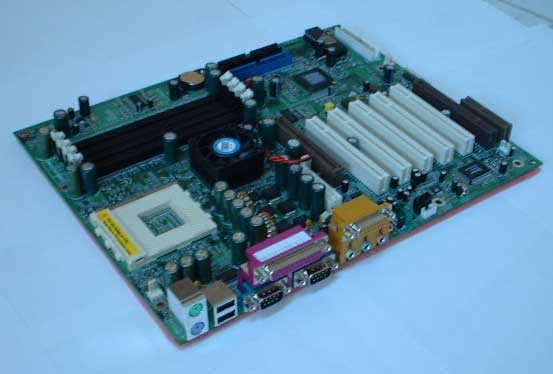 |
|
|
|
In the Forums... |
Posted: October 1st, 2001 Written by: Tuan Huynh Biostar M7VIB  Though Biostar isnít a very well known company, theyíve been creating motherboards for a very long time. Their target audience has been mostly OEMís and not the consumer market. One of Biostarís newest AMD motherboards is the M7VIB. It sports VIAís KT266 chipset with support for DDR. Expansion-wise the M7VIB doesnít lack anything, and features 1 AGP4x, 5 PCI, 1 ACR, and 1 CNR slot for maximum expansion. Since Biostar chose to install an ACR slot for OEMís, a PCI slot had to be sacrificed to make room on the PCB. Unlike most manufacturers who just use a reverse a white PCI slot for ACR, Biostar went the extra mile to make it brown so users wonít get confused and plug-in their PCI slots into the ACR slot on accident. The M7VIB also features 4 DIMM slots with a maximum capacity of three gigabytes of ram. It also uses the VIA 233 southbridge which means no SB Live data corruption problems, but SB Live audio skipping will still occur. Since it uses the 233 southbridge, it has support for two ATA100 channels providing a maximum of 4 IDE devices. On the connector side of things, the M7VIB features the typical ATX layout with 2 PS2 ports, 2 USB, 2 Serial, 1 Parallel, and onboard sound connectors. All the connectors are color coded to PC-99 specifications with the exception of the USB ports. The USB ports are upgradeable with USB headers, which arenít included; but up to 4 more ports can be added with the headers. The onboard sound is nothing interesting, only VIA ACí97 two channel onboard sound. The power connector is located in front of the AGP slot, which is a bad place for the power connector. When the PSU is plugged in, the cable gets in the way of the CPU fan or heatsink, which can be a fire hazard if you donít organize your cables and the CPU fan cuts the power cable or heatsink melts it. When it comes to the manual and instructions, Biostar includes a quick start guide that shows you the jumper settings and front panel connectors. The full manual is on the driver CD-Rom. This is a bad idea used for cutting costs since you wouldnít be able to find out whatís wrong with your board if it doesnít boot up unless you have access to another computer. But besides that, Biostar opted to include an OEM version of Norton Antivirus and Norton Ghost. The versions included are not Windows 2000 compatible, which is a bummer for Win2k users. BIOS The M7VIB uses the typical Award Bios 6 with a few tweaking features. Under Advanced Features, DRAM Clock Driving control, Biostar offers a few memory tweaking features found on the majority of motherboards currently floating around the market. It features the normal DRAM Timing, CAS Timing, Bank interleaving, and DRAM Command rate settings. Biostar also offers the option for you to run the memory and Front Side bus asynchronously so you can use PC1600 memory with your Athlon 266MHz FSB processor. On the overclocking side of things, the M7VIB offers very limited overclocking settings. Under voltage control, Biostar allows a maximum +0.275v setting allowing you to reach over 2.1volts. Unfortunately, the FSB settings differ from the voltage controls, and are extremely limited. The board doesnít support overclocking of the FSB in increments of 1 MHz that can be found on many other boards. This can be understood since the board is aimed towards OEM buyers, where they want to strip the board of as many fancy features as possible; but if Biostar wants to get into the enthusiast market, they need to give users what they want. |
||
|
| |||
|---|---|---|---|